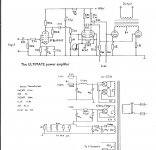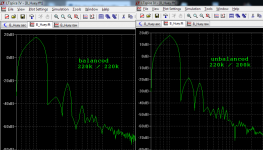Not necessarily, I did some experimentation in this video - Class A PP 807 valve amp prototype experimentation. - YouTube unbalancing experiment is at about 19:00. I found it increases 2H content a bit, but 3H goes up too, as does all other harmonics. The ammount of increase/decrease is probably inaudible.
Andy.
Andy.
Tobruk,
I think that the results depend on how you un-balance the output stage of the push pull amplifier.
First of all, lots of global negative feedback can do a pretty good job of partially "hiding" some of the 2nd harmonic of an un-balanced push pull output stage.
And to a lesser "hiding" effect, so can using either Ultra Linear (which is local negative feedback), or output stage cathode local negative feedback.
1. If you unbalance the DC plate currents in the output transformer, it will cause early saturation of the laminations (sooner than if the DC currents are balanced), especially for loud low frequency music tones.
But negative feedback, global, UL, or cathode, makes this worse, not better.
This is probably not a good way to generate 2nd harmonic, because of the other tradeoffs that come along with it.
2. If you do not use any global, UL, or output stage cathode feedback (do not use negative feedback), then if you vary the gain of the push tube versus the pull stage, it will cause some 2nd harmonic distortion.
Select similar tube types that have different transconductance, then adjust the bias to balance their DC currents in the output transformer.
But this may not be a very good idea either; only a trial amplifier will tell.
3. Or, do not use any global negative feedback (but can use UL or output stage cathode feedback).
Then, change one of the driver plate load resistors, and un-match the resistance.
That will cause 2nd harmonic distortion that goes to the output stage (and with the output stage that is balanced), so the amplifier output will have the 2nd harmonic distortion you are seeking.
4. Or, make the driver and output stages balanced, and change the input stage parameters to have 2nd harmonic distortion.
I think #4 is best, and #3 is next best to do the job.
I hope this can give you some ideas to try.
I think that the results depend on how you un-balance the output stage of the push pull amplifier.
First of all, lots of global negative feedback can do a pretty good job of partially "hiding" some of the 2nd harmonic of an un-balanced push pull output stage.
And to a lesser "hiding" effect, so can using either Ultra Linear (which is local negative feedback), or output stage cathode local negative feedback.
1. If you unbalance the DC plate currents in the output transformer, it will cause early saturation of the laminations (sooner than if the DC currents are balanced), especially for loud low frequency music tones.
But negative feedback, global, UL, or cathode, makes this worse, not better.
This is probably not a good way to generate 2nd harmonic, because of the other tradeoffs that come along with it.
2. If you do not use any global, UL, or output stage cathode feedback (do not use negative feedback), then if you vary the gain of the push tube versus the pull stage, it will cause some 2nd harmonic distortion.
Select similar tube types that have different transconductance, then adjust the bias to balance their DC currents in the output transformer.
But this may not be a very good idea either; only a trial amplifier will tell.
3. Or, do not use any global negative feedback (but can use UL or output stage cathode feedback).
Then, change one of the driver plate load resistors, and un-match the resistance.
That will cause 2nd harmonic distortion that goes to the output stage (and with the output stage that is balanced), so the amplifier output will have the 2nd harmonic distortion you are seeking.
4. Or, make the driver and output stages balanced, and change the input stage parameters to have 2nd harmonic distortion.
I think #4 is best, and #3 is next best to do the job.
I hope this can give you some ideas to try.
Last edited:
Tobruk,
One advantage of a push pull amplifier is that the damping factor of the positive alternation is the same as the damping factor of the negative alternation.
Many woofers perform better with that.
One disadvantage with a single ended amplifier is that the damping factor of the positive alternation is different than the damping factor of the negative alternation.
Many woofers do not perform as well with that.
So, if you un-balance the push pull output stage, the damping factor of the positive alternation is different than the damping factor of the negative alternation.
Many woofers do not perform as well with that.
So, Instead, introduce the 2nd harmonic distortion in an earlier stage (not the output stage), and it will retain the equal damping of the positive and negative alternations.
That will make many woofers to perform better versus with the output stage un-balanced.
Just my opinions.
One advantage of a push pull amplifier is that the damping factor of the positive alternation is the same as the damping factor of the negative alternation.
Many woofers perform better with that.
One disadvantage with a single ended amplifier is that the damping factor of the positive alternation is different than the damping factor of the negative alternation.
Many woofers do not perform as well with that.
So, if you un-balance the push pull output stage, the damping factor of the positive alternation is different than the damping factor of the negative alternation.
Many woofers do not perform as well with that.
So, Instead, introduce the 2nd harmonic distortion in an earlier stage (not the output stage), and it will retain the equal damping of the positive and negative alternations.
That will make many woofers to perform better versus with the output stage un-balanced.
Just my opinions.
Here is one experimenters try at doing just that about 25 yrs ago. The unbalanced drive results are partially cancelled by the PP power stage. If any overall -NFB is applied it will further reduce the 2H. And while doing that create some very interesting higher order THD & IMD products. Looks like a losers amp to me.🙄
Attachments
I thank you for your very interesting technical comments,unfortunately I am a beginner,but I want to ask you what would be the phase splitter circuit which naturally produces the greatest amount of 2° thd
(excuse my bad English please)
thanks
(excuse my bad English please)
thanks
Last edited:
jhstewart9,
Thanks for your informative post.
So, from your posted example, just an LTP phase splitter with un-equal plate loads does not seem to do a good job of creating lots of 2nd harmonic distortion after it passes through the output stage, and perhaps creates other [undesired] distortions as well.
Perhaps the best way to create some 2nd harmonic distortion is to have both the driver and output stages as balanced as possible, with as little 2nd harmonic distortion as possible . . .
Then feed the phase splitter with an input stage that is purposely designed to create lots of 2nd harmonic distortion.
Obviously, the triode wired EF86 does not normally do that, at any reasonable quiescent state, it is quite linear.
If an input stage that has lots of 2nd harmonic distortion does not cause lots of 2nd harmonic to appear from the push pull output, then I would say that the same amplifier would be cancelling the 2nd harmonic that is naturally present in a musical instrument.
Some would say that is a sad state of affairs.
Thanks for your informative post.
So, from your posted example, just an LTP phase splitter with un-equal plate loads does not seem to do a good job of creating lots of 2nd harmonic distortion after it passes through the output stage, and perhaps creates other [undesired] distortions as well.
Perhaps the best way to create some 2nd harmonic distortion is to have both the driver and output stages as balanced as possible, with as little 2nd harmonic distortion as possible . . .
Then feed the phase splitter with an input stage that is purposely designed to create lots of 2nd harmonic distortion.
Obviously, the triode wired EF86 does not normally do that, at any reasonable quiescent state, it is quite linear.
If an input stage that has lots of 2nd harmonic distortion does not cause lots of 2nd harmonic to appear from the push pull output, then I would say that the same amplifier would be cancelling the 2nd harmonic that is naturally present in a musical instrument.
Some would say that is a sad state of affairs.
Tobruk,
It appears to me that you want an amplifier that has lots of 2nd harmonic distortion.
Is that correct?
Perhaps a 2 stage Single Ended amplifier that has an output stage that has lots of 2nd harmonic distortion, and an input stage that is extremely linear with no 2nd harmonic distortion, so that there is no 2nd harmonic distortion cancellation between the input and output stages.
Decades ago, I read about a pair of 200 Watt single ended amplifiers, that used 1500 Watt Eimac linear triodes, if lack of SE power is the problem.
It appears to me that you want an amplifier that has lots of 2nd harmonic distortion.
Is that correct?
Perhaps a 2 stage Single Ended amplifier that has an output stage that has lots of 2nd harmonic distortion, and an input stage that is extremely linear with no 2nd harmonic distortion, so that there is no 2nd harmonic distortion cancellation between the input and output stages.
Decades ago, I read about a pair of 200 Watt single ended amplifiers, that used 1500 Watt Eimac linear triodes, if lack of SE power is the problem.
The OP asked for the effects of "slight unbalance" not maximising 2nd H.
I did a sim on a simple practical pp-amp which many build ... BabyHuey @ 2W output.
Has gobal FB, shade FB and UL.
Unbalancing was done by changing component values.
1) 10% unbalance in bias current for output tubes: little effect
2) different tube model for outputs, EL84 Koren / 6BG8 Ayumi: little effect
3) 10% unbalance of splitter / driver plate resistors: 20dB more 2nd, 6dB less 5th
4) 5% unbalance in transformer ratio: similar to 3)
It seems that slightly unbalancing the phase splitter is the way to go even in the presence of all sorts of FB.
I did a sim on a simple practical pp-amp which many build ... BabyHuey @ 2W output.
Has gobal FB, shade FB and UL.
Unbalancing was done by changing component values.
1) 10% unbalance in bias current for output tubes: little effect
2) different tube model for outputs, EL84 Koren / 6BG8 Ayumi: little effect
3) 10% unbalance of splitter / driver plate resistors: 20dB more 2nd, 6dB less 5th
4) 5% unbalance in transformer ratio: similar to 3)
It seems that slightly unbalancing the phase splitter is the way to go even in the presence of all sorts of FB.
Attachments
- Home
- Amplifiers
- Tubes / Valves
- Push pull THD

